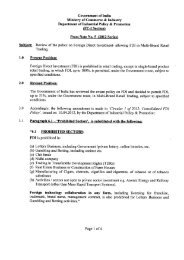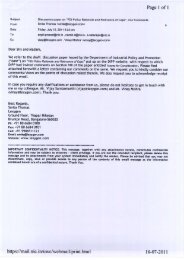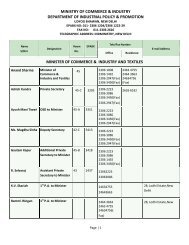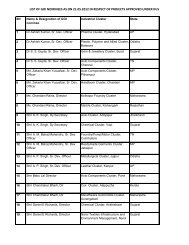fdi in india and its growth linkages - Department Of Industrial Policy ...
fdi in india and its growth linkages - Department Of Industrial Policy ...
fdi in india and its growth linkages - Department Of Industrial Policy ...
Create successful ePaper yourself
Turn your PDF publications into a flip-book with our unique Google optimized e-Paper software.
FDI IN INDIA AND ITS GROWTH LINKAGES<br />
In order to check the geographical spread of the FDI firms vis-à-vis domestic firms, we categorised the firms based on<br />
the number of states <strong>in</strong> which they had plant locations (Tables 6.20 <strong>and</strong> 6.21). Such a spread has been computed for<br />
firms hav<strong>in</strong>g plants <strong>in</strong> one or more states.<br />
There are 190 (out of 351) FDI firms with plants <strong>in</strong> only one state with 317 (out of 1,171) plants. This implies that<br />
there are about 2 plants per FDI manufactur<strong>in</strong>g firm <strong>and</strong> about 57 per cent of these plants are located <strong>in</strong> Class-3 cities.<br />
72 FDI firms have 248 plants spread over two different states, with 60 per cent of the plants located <strong>in</strong> Class-3 cities.<br />
Fewer firms have plants spread over three or more states. Eleven FDI firms have plants spread over five different states,<br />
with a total of 96 plants, <strong>and</strong> the rema<strong>in</strong><strong>in</strong>g 15 firms have an even wider spread (more than five states), with a total of<br />
207 plants. The average number of plants per firm is greater <strong>in</strong> wider-spread firms than <strong>in</strong> less-spread firms. While firms<br />
with plants <strong>in</strong> only one state have 1.7 plants per firm, those with a spread across five states have 8.7 plants per firm, <strong>and</strong><br />
for firms with plants spread across more than five states, the number shoots up to 13.8. However, it may be noted that<br />
the average number of plants per firm <strong>in</strong> one state rema<strong>in</strong>s nearly uniform over firms with plants spread over one to five<br />
states, although it <strong>in</strong>creases for firms with plants spread over more than five states. About 53 per cent of the FDI<br />
manufactur<strong>in</strong>g plants (622 out of 1,171) are located <strong>in</strong> Class-3 cities (Table 6.20).<br />
The scenario is strik<strong>in</strong>gly similar <strong>in</strong> the case of domestic manufactur<strong>in</strong>g firms. There are 3,107 firms with 8,485 plants,<br />
thus imply<strong>in</strong>g 2.7 plants per firm on average (Table 6.21). About 54 per cent of the domestic manufactur<strong>in</strong>g firms are<br />
located <strong>in</strong> Class-3 cities. The average number of plants per firm as well as the number of plants per firm per state across<br />
the state-wise spread of firms closely matches that of the FDI manufactur<strong>in</strong>g firms. For example, the average number<br />
of plants per firm for firms with plants <strong>in</strong> only one state is 1.6 for domestic manufactur<strong>in</strong>g firms <strong>and</strong> 1.7 for FDI<br />
manufactur<strong>in</strong>g firms. The correspond<strong>in</strong>g number of plants per firm for firms spread across five states is 8.9 for domestic<br />
manufactur<strong>in</strong>g firms <strong>and</strong> 8.7 for FDI manufactur<strong>in</strong>g firms. The average number of plants per firm per state is <strong>in</strong> the<br />
range of 1.7 <strong>and</strong> 1.8 <strong>in</strong> both cases, viz., domestic <strong>and</strong> FDI firms.<br />
About 72 per cent of the FDI-enabled 1,171 plants (841 plants) are concentrated <strong>in</strong> seven states (Table 6.22).<br />
Maharashtra has the highest number of plants followed by Tamil Nadu, Gujarat, Andhra Pradesh <strong>and</strong> Karnataka. About<br />
41 per cent of the 841 plants are concentrated <strong>in</strong> Class-3 cities. With<strong>in</strong> Karnataka, the share of FDI-enabled<br />
manufactur<strong>in</strong>g plants <strong>in</strong> Class-3 cities is 49 per cent.<br />
6.3.2 Sectoral Spread of Equity, Fixed Capital <strong>and</strong> Market Capitalisation<br />
Capital<strong>in</strong>e database provides an NIC 3-digit code for each firm. It also provides <strong>in</strong>formation on foreign <strong>and</strong> domestic<br />
equity, market capitalisation <strong>and</strong> net fixed capital. This enables us to check the spread of these variables across NIC<br />
3-digit sectors8 (Tables 6.23-6.31). All the 351 FDI firms <strong>and</strong> 3,107 domestic firms have been distributed across 101<br />
3-digit NIC sectors. It may, however, be noted that some of the domestic firms also have foreign equity participation,<br />
albeit less than 10 per cent of the total equity.<br />
The market capitalisation of all firms (FDI <strong>and</strong> domestic) is estimated at Rs. 32,309 billion, <strong>in</strong>clud<strong>in</strong>g Rs. 4,870 billion<br />
for the FDI firms. The all-India total equity capital <strong>in</strong> FDI <strong>and</strong> domestic sectors is Rs. 1,316 billion, with Rs. 1,203<br />
billion <strong>in</strong> domestic firms <strong>and</strong> Rs. 113 billion <strong>in</strong> FDI firms (Table 6.23). The foreign equity component is Rs. 56.2 billion,<br />
with Rs. Rs. 49.4 billion <strong>in</strong> FDI firms <strong>and</strong> Rs. 6.8 billion <strong>in</strong> domestic firms. 9<br />
8. Equity capital is computed on the basis of the face value of the shares <strong>and</strong> not at market valuation.<br />
9. Equity amount is based on the book value of assets <strong>and</strong> hence is Rs. 56 billion worth of foreign equity, which does not match FDI <strong>in</strong>flows. While mergers<br />
<strong>and</strong> acquisitions pay for shares at market prices greenfield FDI also pays the premium over <strong>and</strong> above the face value of the shares at the time of buy<strong>in</strong>g<br />
new issues. In order to f<strong>in</strong>d a proxy estimate for FDI <strong>in</strong>flows, we have computed market capitalisation of foreign equity shares. It turns out to be Rs.<br />
2,65,106 crore.<br />
62












